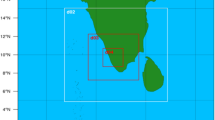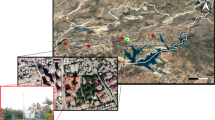Abstract
We detected a severe haze process in Guangzhou area with lidar and microwave radiometer, performed an inversion to get boundary layer height by wavelet covariance transform, and analyzed the correlation between meteorological factors of boundary layer and visibility from the perspective of dynamical and thermodynamic structures. Our results indicate that the boundary layer height shows significant daily changes, consistent with ground visibility variation. During the cleaning process, the boundary layer height exceeded 1 km; during severe haze, the height was only 500 m. Temperature gradient of 50–100 m, which was 30 h lag, was remarkably correlated with visibility, with the correlation coefficient of 0.77. High layer visibility (255 m) and low layer stability were significantly anticorrelation, and the maximum anticorrelation coefficient was up to −0.76 in cleaning days and −0.49 in haze days. In the related boundary layer meteorological factors, surface ventilation coefficient was linearly correlated with ground visibility, with the greatest correlation coefficient of 0.88. The correlation coefficients of boundary layer height, ground wind velocity, relative humidity and ground visibility were 0.76, 0.67, and −0.77, respectively. There was a strong correlation between different meteorological factors. The dominant meteorological factor during this haze process was surface ventilation coefficient. In the area without boundary layer height sounding, ground visibility and wind velocity could be used to estimate boundary layer height.
Similar content being viewed by others
References
Badarinath K V S, Latha K M. 2006. Direct radiative forcing from black carbon aerosols over urban environment. Adv Space Res, 37: 2183–2188
Brooks I M. 2003. Finding boundary layer top: Application of a wavelet covariance transform to lidar backscatter profiles. J Atmos Ocean Technol, 20: 1092–1105
Cheng P X, Mao J T, Li J G, et al. 2003. Atmospheric Physics (in Chinese). Beijing: China Peking University Press
Cohn S A, Angevine W M. 2000. Boundary-layer height and entrainment zone thickness measured by lidars and wind profiling radars. J Appl Meteorol, 39: 1233–1247
Davis K J, Gamage N, Hagelberg C, et al. 2000. An objective method for deriving atmospheric structure from airborne lidar observations. J Atmos Ocean Technol, 17: 1455–1468
Deng T, Zhang L, Wu D, et al. 2010a. High cloud and aerosol optical property and its influence in heating rate over Lanzhou (in Chinese). Plateau Meteorol, 29: 230–235
Deng T, Zhang L, Chen M, et al. 2010b. The influence of high cloud and aerosol radiative effect on boundary layer (in Chinese). Chin J Atmos Sci, 34: 979–987
Deng T, Wu D, Deng X J, et al. 2012. Simulation of a typical complex pollution process over Pearl River Delta area (in Chinese). Chin Environ Sci, 32: 193–199
Deng X J, Li F, Wu D, et al. 2011. Turbulence and mass exchange characteristics of typical clean and pollution process over Guangzhou region (in Chinese). Chin Environ Sci, 31: 1424–1430
Ding G A, Chen C Y, Gao Z Q, et al. 2005. Vertical structures of PM10 and PM2.5 and their dynamical character in low atmosphere in Beijing urban areas. Sci China Ser D-Earth Sci, 48(Supp II): 38–54
Fan S J, Wang B M, Tesche M, et al. 2008. Meteorological conditions and structures of atmospheric boundary layer in October 2004 over Pearl River Delta area. Atmos Environ, 42: 6174–6186
Fernald F G. 1984. Analysis of atmospheric lidar observations: Some comments. Appl Optics, 23: 652–653
Gamage N, Hagelberg C. 1993. Detection and analysis of microfronts and associated coherent events using localized transforms. J Atmos Sci, 50: 750–756
He Q S, Mao J T. 2005. Observation of urban mixed layer at Beijing using a Micro-Pulse Lidar (in Chinese). Acta Meteorol Sin, 63: 374–384
Jayaraman A, Gadhavi H, Ganguly D, et al. 2006. Spatial variations in aerosol characteristics and regional radiative forcing over India: Measurements and modeling of 2004 road campaign experiment. Atmos Environ, 40: 6504–6515
Li T Y, Deng X J, Fan S J, et al. 2012. Study on air quality and pollution meteorology conditions of Guangzhou during the 2010 Asian Games (in Chinese). Environ Sci, 33: 2932–2938
Mallet M, Pont V, Liousse C, et al. 2006. Simulation of aerosol radiative properties with the ORISAM-RAD model during a pollution event. Atmos Environ, 40: 7696–7705
Steyn D G, Baldi M, Hoff R M, et al. 1999. The detection of mixed layer depth and entrainment zone thickness from lidar backscatter profiles. J Atmos Ocean Technol, 16, 953–959
Tang X Y, Zhang Y H, Shao M. 2006. Atmospheric Environment Chemistry (in Chinese). 2nd ed. Beijing: Higher Education Press
Tie X X, Wu D, Brasseur G, et al. 2009. Lung cancer mortality and exposure to atmospheric aerosol particles in Guangzhou, China. Atmos Environ, 43: 2375–2377
Welton E J, Voss K J, Gordon H R, et al. 2000. Ground-based lidar measurements of aerosols during ACE-2: Instrument description, results, and comparisons with other ground-based and airborne measurements. Tellus, 52B: 636–651
Welton E J, Voss K J, Quinn P K, et al. 2002. Measurements of aerosol vertical profile and optical properties during INDOEX 1999 using micrpulse lidars. J Geophys Res, 107: 8019–8041
Wu D, Tie X X, Li C C, et al. 2005. An extremely low visibility event over the Guangzhou region: A case study. Atmos Environ, 39: 6568–6577
Wu D, Bi X Y, Deng X J, et al. 2006a. Heavy haze weather resulting from aerosol cloud over Pearl River Delta (in Chinese). J Nat Disaster, 15: 77–83
Wu D, Bi X Y, Deng X J, et al. 2006b. Effect of atmospheric haze on the deterioration of visibility over the Pear River Delta (in Chinese). Acta Meteorol Sin, 64: 510–517
Wu D, Deng X J, Bi X Y, et al. 2007. Study on the visibility reduction caused by atmospheric haze in Guangzhou area (in Chinese). J Trop Meteorol, 23: 1–6
Xu W Y, Zhao C S, Ran L, et al. 2011. Characteristics of pollutants and their correlation to meteorological conditions at a suburban site in the North China Plain. Atmos Chem Phys, 11: 4353–4369
Xu X D, Shi X H, Xie L, et al. 2005. Spatial character of the gaseous and particulate state compound correlation of urban atmospheric pollution in winter and summer. Sci China Ser D-Earth Sci, 48(Supp II): 64–79
Zhang J P, Zhu T, Zhang Q H, et al. 2012. The impact of circulation patterns on regional transport pathways and air quality over Beijing and its surroundings. Atmos Chem Phys, 12: 5031–5053
Zhou M Y, Yao W Q, Xu X D, et al. 2005. Vertical dynamic and thermodynamic characteristics of urban lower boundary layer and its relationship with aerosol concentration over Beijing. Sci China Ser D-Earth Sci, 48(Supp II): 25–37
Author information
Authors and Affiliations
Corresponding author
Rights and permissions
About this article
Cite this article
Deng, T., Wu, D., Deng, X. et al. A vertical sounding of severe haze process in Guangzhou area. Sci. China Earth Sci. 57, 2650–2656 (2014). https://doi.org/10.1007/s11430-014-4928-y
Received:
Accepted:
Published:
Issue Date:
DOI: https://doi.org/10.1007/s11430-014-4928-y




